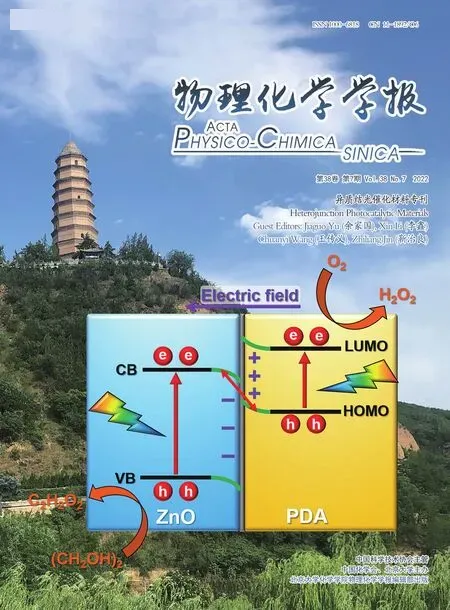Insights into Mechanism of CsPbBr3 Nanocrystal Interfacial Modifier in Perovskite Solar Cells
S. Wageh , Ahmed A. Al-Ghamdi , Li Zhao
1 Department of Physics, Faculty of Science, King Abdulaziz University, Jeddah 21589, Saudi Arabia.
2 Hubei Collaborative Innovation Center for Advanced Organic Chemical Materials, Ministry of Education Key Laboratory for the Green Preparation and Application of Functional Materials, School of Materials Science and Engineering, Hubei University,Wuhan 430062, China.

(a-b) Transient TA spectra and (c) normalized decay kinetic curves of FTO/SnO2/PSK and FTO/SnO2/CN/PSK.Schematics for electron excitation and extraction at the interfaces (d) between SnO2 and PSK or (e) between SnO2 and CN/PSK. (f) Schematic for the changes of Fermi level at PSK/ETL interface and PSK/HTL interface.Adapted with permission from Ref. 9. Copyright 2021, Wiley-VCH.
During the past decade, organic-inorganic hybrid perovskite solar cell (PSC) has attracted great attention in the photovoltaic field1,2. As the third-generation solar cell, PSC in laboratory has already achieved certified power conversion efficiency (PCE)exceeding 25%. The superb photovoltaic performance of PSC is attributed to the unique optoelectronic properties of organicinorganic halide perovskite light absorption layer, including low exciton binding energy, high absorption coefficients, and outstanding carrier mobility3,4. Hence, the quality of perovskite film plays a decisive role in the photovoltaic performance of PSC. Defects are inevitably formed on the surface and inside of polycrystalline perovskite film during the conventional preparation methods. It’s widely acknowledged that defects are the recombination centers of photogenerated electrons and holes,resulting in the loss of useful photogenerated charges5,6.Therefore, decreasing the charge loss is advantageous to improving the PCE of PSC.
With the tremendous efforts of researchers in photovoltaic field, numerous research works have successfully reduced charge loss through additive engineering, heterojunction construction, and interfacial modification7,8. However, the modifiers utilized in these works are typically polymers, salts,and molecules. Their components and structures are totally different from that of perovskite, leading to the poor physicochemical compatibility with perovskite film.Consequently, developing modifiers which possess similar chemical composition and crystal structure with perovskite would be a more sensible choice. Inorganic metal halide perovskite nanocrystals have crystal size in dozens of nanometers, but still maintain the outstanding photoelectric properties of bulk perovskite. Some research works have verified the significance of perovskite nanocrystal in interfacial modification. Nevertheless, the perovskite nanocrystals in these works are generally prepared through hot-injection method. In addition, none work has investigated the functions of perovskite nanocrystal in bilateral interface modification of perovskite film,and the mechanism of perovskite nanocrystal induced interface modification requires deeper exploration.
To address these aforementioned issues, Jiaguo Yu (Wuhan University of Technology) and Tao Chen (University of Science and Technology of China)et al.recently reported a roomtemperature synthesized CsPbBr3nanocrystal (CN) and investigated the effects and mechanism of CN in the bilateral interface modification of CH3NH3PbI3(MAPbI3) perovskite film (AdvancedScience2021,8,2102648. doi:10.1002/advs.202102648)9. CN is prepared by quickly injecting excess lead salt precursor into the violently stirred cesium salt precursor at room-temperature. The CN bilateral interface modification of perovskite film is composed of CN bottom modification and CN top modification. The as-synthesized CN is spin-coated on to the SnO2electron transport layer (ETL) to accomplish the CN bottom modification. CN top modification is realizedviautilizing CN dispersed anhydrous toluene as the antisolvent during the one-step preparation process of perovskite film. As for the CN bottom modification, CN at surface of SnO2ETL is able to serve as the seed crystal, facilitating the seedmediated growth of perovskite film (PSK). Hence, the defects at SnO2/PSK interface can be effectively decreased. Femtosecond transient absorption (fs-TAS) characterization is conducted to investigate the electron transfer dynamics at SnO2/PSK interface. The photobleaching peaks at ≈ 760 nm (PB2) are ascribed to the photo-induced carrier population in perovskite film (Fig. a,b). Furthermore, the electron injection time (τinjection)can be obtained through bi-exponential fitting of the decay kinetic curves at 759 nm (Fig. c). Theτinjectionis decreased from 611 to 258 ps with CN bottom modification, illustrating that CN can passivate the interfacial defects and promote the electron extraction process (Fig. d,e). Concerning CN top modification, a gradational doping of CN is formed at the upper part of perovskite film.In situKelvin probe force microscopy andin situCPD detection characterizations confirm that the Femi level(Ef) of PSK surface is lowered after CN top modification both under dark condition and illumination. Accordingly, the Fermi level difference between the surface and bottom of the film has increased (Fig. f), contributing to enlarged built-in electric field.This suggests the separation of photogenerated electrons and holes is significantly improved with CN top modification.Combining the merits of CN bottom modification and top modification, CN bilateral interface modified planar PSC exhibits average PCE exceeding 20%.
To briefly conclude, this work has provided mechanism insights into the functions of CN in the interfacial modification of perovskite. Controllable preparation of CN at roomtemperature is achieved, and boosted built-in electric field contribute to efficient separation of photogenerated electrons and holes inside PSC. This novel research work has also revealed the potential of perovskite nanocrystal-based modifiers in photoelectric devices including photovoltaics, LEDs, and photodetectors.
Acknowledgments:This project was funded by the Deanship of Scientific Research (DSR) at King Abdulaziz University, Jeddah (Grant No. RG-72-130-42). The authors,therefore, acknowledge with thanks DSR for technical and financial support.
- 物理化學學報的其它文章
- Core-Shell Au@NiS1+x Cocatalyst for Excellent TiO2 Photocatalytic H2 Production
- Efficient Degradation of Tetracycline via Coupling of Photocatalysis and Photo-Fenton Processes over a 2D/2D α-Fe2O3/g-C3N4 S-Scheme Heterojunction Catalyst
- Enhanced Photocatalytic H2O2 Production over Inverse Opal ZnO@Polydopamine S-Scheme Heterojunctions
- Construction of 1D/2D W18O49/Porous g-C3N4 S-Scheme Heterojunction with Enhanced Photocatalytic H2 Evolution
- Enhancement of Photocatalytic H2-Evolution Kinetics through the Dual Cocatalyst Activity of Ni2P-NiS-Decorated g-C3N4 Heterojunctions
- P-Doped g-C3N4 Nanosheets with Highly Dispersed Co0.2Ni1.6Fe0.2P Cocatalyst for Efficient Photocatalytic Hydrogen Evolution

